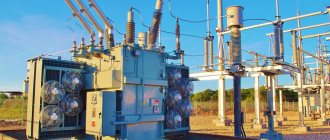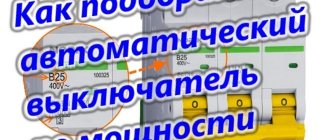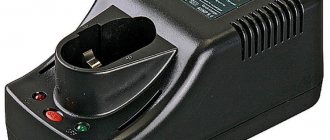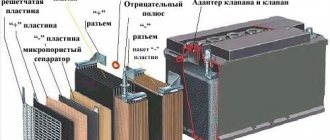What is power Watt [W]
Power is a quantity that determines the ratio of work performed by a current source over a certain period of time. One watt corresponds to the product of one ampere and one volt, but when determining energy costs, the value of kilowatt/hour .
It corresponds to the consumption of one thousand watts for 60 minutes of operation. It is by this indicator that the cost of electricity services is determined.
In most cases, the power consumed by the device is indicated in the technical documentation or on the packaging. The specified quantity is produced in one hour of work.
For example, a computer with a 500 W power supply will spin 1 kW for 2 hours of operation.
To help determine the current strength at a known power, a calculator will help, which converts one physical quantity to another.
Units
In Russia, the International System of Units (SI), adopted in 1960 at the General Conference on Weights and Measures, is widely used. There are only seven system-forming basic physical quantities in the SI system:
- electric current strength - I (ampere, denoted by the capital letter A in honor of the French researcher André-Marie Ampere (1775−1836), who made a great contribution to the study of electromagnetic phenomena;
- length - L (meter, m);
- time - T (second, s);
- mass - M (kilogram, kg);
- thermodynamic temperature - q (kelvin, K);
- luminous intensity - J (candela, cd);
- amount of substance - N (mol).
Any other physical quantities are combinations of the basic ones. For example, volume is L3 (cubic meter, m3). Current strength in electrical engineering can be determined using Ohm's law and its derivative units - voltage (U, volts) and resistance (R, ohm): I=U / R.
https://youtube.com/watch?v=7ZOXnl2rdM4
What is Current Strength. Ampere [A]
Current is the speed at which electrical charge flows through a conductor. One ampere is equal to a charge of one coulomb that passes through a conductor in one second. One coulomb represents a very large charge, so in most devices this value is measured in milliamps.
The current strength depends on the cross-section of the conductor and its length. This must be taken into account when planning structures, as well as choosing electrical appliances. Although most should not think about this, since this is the task of engineers and designers.
How many watts are in 1 ampere?
To determine the power of a circuit, the concept of voltage is also important. This is the electromotive force that moves electrons. It is measured in volts. Most devices have this characteristic in their documentation.
To determine the power at a current of one ampere, you need to know the network voltage. So, for a 220 volt outlet it will be: P = 1 * 220 = 220 W. Formula for calculation: P = I*U, where I is current and U is voltage. In a three-phase network, a correction factor must be taken into account, reflecting the percentage of operating efficiency. In most cases it is between 0.67 and 0.95.
Physical units characterizing a household electrical network
Most readers are well aware of these quantities from school - they are necessarily included in the basic physics course. However, information that has not been in demand for a long time tends to hide in the depths of consciousness, so let’s “refresh” it.
- In order for electric current to flow through a closed circuit, voltage must be present. And voltage is the potential difference at opposite ends of the circuit - most often considered from the power source. The potential itself is the amount of electric charge accumulated at a given point, in fact, its energy capacity. Both the potential and its difference are calculated in volts (V).
Measuring voltage in a household AC network
Voltage can be constant (which, for example, motorists know well), or alternating, in which the poles change places with a certain frequency. This gives many preferences in matters of transmitting electricity over long distances and using it for its intended purpose. That is why in everyday life we often have to deal with alternating voltage - 220 volts (V) at a frequency of 50 hertz (Hz).
- If the voltage (potential difference) is large enough to “push” charge carriers (electrons, ions) through a closed circuit through the load, an electric current appears in this circuit. It is characterized by a special quantity - current strength, which shows how much charge has passed through a specific point per unit of time, that is, per second. For current strength, a special unit of measurement is “allocated” - ampere (A).
Measuring current strength with an ammeter can be much more difficult - the device must be connected in series with the tested section (element) of the circuit, that is, it is necessary to organize an artificial break in the circuit.
- Current is passed through the load for a reason - it is expected to perform a certain job, most often associated with the conversion of electrical energy into another - kinetic, thermal, sound, etc. The quantitative expression of the work performed per unit of time is precisely power. It has its own unit of measurement - watt (W).
It is this power that we will learn to estimate based on the current strength in the circuit. And, naturally, vice versa.
Any electrical circuit is always characterized by resistance - overall, and in individual sections. And resistance, by the way, directly affects the power consumption of the circuit. But for our task formulated above, we can do without it - resistance does not appear in the basic formula.
Since we are talking about basic formulas, it’s time to remind them.
So, according to Ohm's law
I= U/ R
Where:
I - current strength (A);
U —voltage (V);
R - resistance (Ohm).
Power in an AC or DC circuit can be described by the following basic formula:
P = U × I
Let us say right away that the reservation about the “basic formula” was not made in vain. In an alternating current circuit, when using certain types of load, this ratio may undergo some transformations - this will be discussed in due course.
So, having determined or initially had the value of one of the parameters, it is not difficult to purely mathematically calculate the indicator of another parameter. In this case, the voltage in the network acts as a kind of “constant”: it is either already known, or is immediately measured with a voltmeter - fortunately, this, unlike the current strength, is not difficult to do.
If you still have questions about the basic physical quantities in electrical engineering, we recommend watching a fairly intelligible video on this topic:
Video: How are the main physical quantities in electrical engineering related to each other?
Ampere – Watt conversion table
To convert watts to amperes, you need to use the previous formula, expanding it. To calculate the current, you need to divide the power by the voltage: I = P/U. The following table shows the amperage for devices with different voltages - 6, 12, 24, 220 and 380 volts.
Remember that for high voltage networks, the specified amperage differs depending on the efficiency.
Table of the ratio of amperes and watts, depending on voltage.
| 6V | 12V | 24V | 220V | 380V | |
| 5 W | 0.83A | 0.42A | 0.21A | 0.02A | 0.008A |
| 6 W | 1.00A | 0.5A | 0.25A | 0.03A | 0.009A |
| 7 W | 1.17A | 0.58A | 0.29A | 0.03A | 0.01A |
| 8 W | 1.33A | 0.66A | 0.33A | 0.04A | 0.01A |
| 9 W | 1.5A | 0.75A | 0.38A | 0.04A | 0.01A |
| 10 W | 1.66A | 0.84A | 0.42A | 0.05A | 0.015A |
| 20 W | 3.34A | 1.68A | 0.83A | 0.09A | 0.03A |
| 30 W | 5.00A | 2.5A | 1.25A | 0.14A | 0.045A |
| 40 W | 6.67A | 3.33A | 1.67A | 0.13A | 0.06A |
| 50 W | 8.33A | 4.17A | 2.03A | 0.23A | 0.076A |
| 60 W | 10.00A | 5.00A | 2.50A | 0.27A | 0.09A |
| 70 W | 11.67A | 5.83A | 2.92A | 0.32A | 0.1A |
| 80 W | 13.33A | 6.67A | 3.33A | 0.36A | 0.12A |
| 90 W | 15.00A | 7.50A | 3.75A | 0.41A | 0.14A |
| 100 W | 16.67A | 3.33A | 4.17A | 0.45A | 0.15A |
| 200 W | 33.33A | 16.66A | 8.33A | 0.91A | 0.3A |
| 300 W | 50.00A | 25.00A | 12.50A | 1.36A | 0.46A |
| 400 W | 66.66A | 33.33A | 16.7A | 1.82A | 0.6A |
| 500 W | 83.34A | 41.67A | 20.83A | 2.27A | 0.76A |
| 600 W | 100.00A | 50.00A | 25.00A | 2.73A | 0.91A |
| 700 W | 116.67A | 58.34A | 29.17A | 3.18A | 1.06A |
| 800 W | 133.33A | 66.68A | 33.33A | 3.64A | 1.22A |
| 900 W | 150.00A | 75.00A | 37.50A | 4.09A | 1.37A |
| 1000 W | 166.67A | 83.33A | 41.67A | 4.55A | 1.52A |
Using the table it is also easy to determine the power if the voltage and current are known. This is useful not only for calculating energy consumption, but also for choosing special equipment responsible for uninterrupted operation or preventing overheating.
Ampere as a unit of measurement:
Ampere is a unit of electrical current in the International System of Units (SI), one of the seven basic SI units, named after the French physicist André Ampere.
Ampere has a Russian designation - A; international designation – A.
An ampere is the strength of a constant current which, if passed through two parallel straight conductors of infinite length and negligibly small circular cross-sectional area, located in a vacuum at a distance of 1 meter from each other, would cause an interaction force equal to 2 on each section of the conductor 1 meter long ⋅10−7 newton (formulation valid until May 20, 2021, adopted by the IX General Conference on Weights and Measures (GCPM) in 1948).
The definition of ampere, based on the use of the numerical value of the elementary electric charge, was adopted at the XXVI General Conference of Weights and Measures (November 16, 2021). The language, effective May 20, 2021, states that the ampere is the SI unit of electrical current. It is defined by fixing the numerical value of the elementary charge to 1.602 176 634⋅10−19, when expressed in unit C, which is equal to A s, where the second is defined by ΔνCs.
The current strength in a conductor is 1 ampere if, in one second, an electric charge equal to 1 coulomb (6.241·10¹⁸ electrons) passes through the cross-section of this conductor.
A = Cl/s.
1 A = 1 C / 1 s.
If a capacitor with a capacity of 1 farad is charged with a current of 1 ampere, then the voltage on the plates will increase by 1 volt every second.
A = (V · F) / s.
1 A = (1 V 1 F) / 1 s.
Magnetomotive force and magnetic potential difference are also measured in amperes (the outdated name is ampere-turn).
In addition, the ampere is one of the basic units in the ICSA system of units.
In accordance with the SI rules concerning derived units named after scientists, the name of the unit ampere is written with a lowercase letter, and its designation is written with a capital letter (A). This spelling of the designation is also preserved in the designations of other derived units formed using the ampere.









